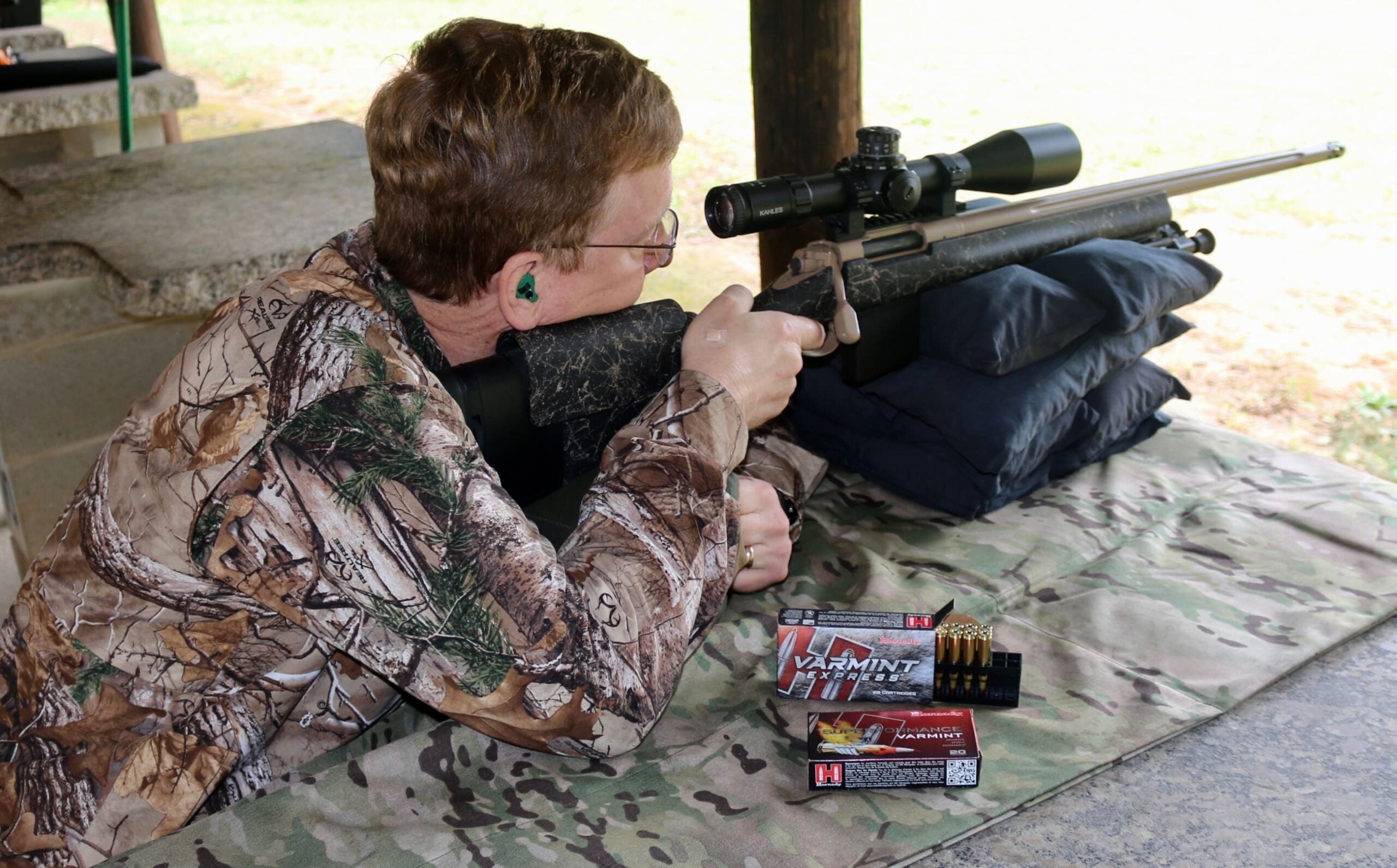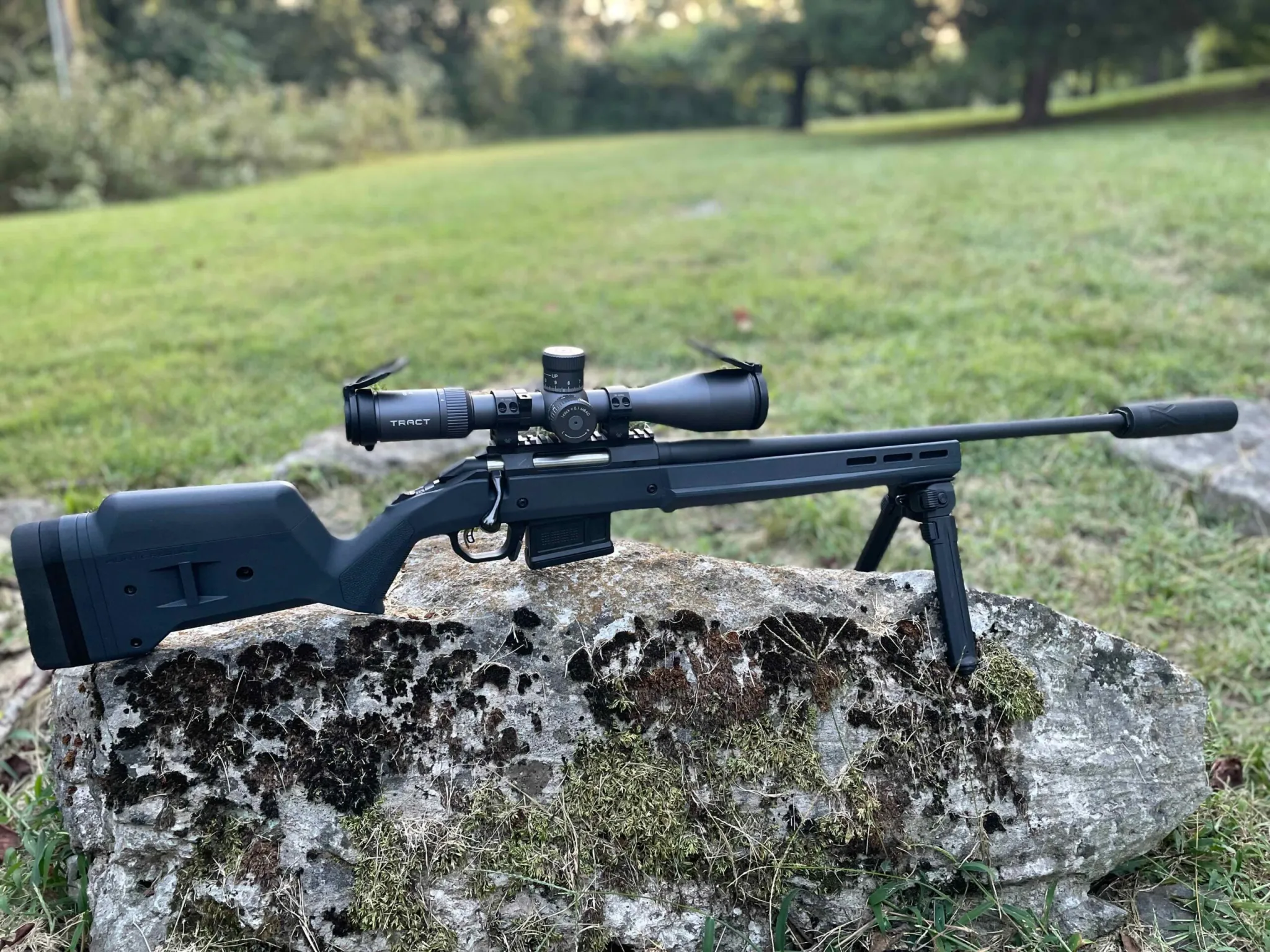
For those unfamiliar with the brand, Kahles is an Austrian optics maker that has been in the business since the 19th century. It’s now a sister company of Swarovski, another maker of high quality optics and rifle scopes.
The Kahles K624i 6-24×56 rifle scope is intended for reaching out and touching targets at long ranges, with its 34mm tube and big 56mm objective lens.

One unique feature of the K624i rifle scope is that it’s available with either a right- or left-side windage turret. This particular scope came with the windage turret on the left side, and the illuminated reticle adjustment on the right. This makes it easy for a right-handed shooter to dial for windage without breaking their grip on the gun with their strong hand.

The lighted reticle was incredibly crisp, and the adjustment is not simply on/off, but allows lower-to-higher intensity of illumination. I turned on the lighted reticle while sighting-in the rifle, just so I could write that I used it. The clarity of the K624i made the lighted reticle unnecessary during the sunlit days in which I was shooting.

One of the features I really liked about this riflescope was the integration of the parallax wheel into the elevation turret. I could make parallax adjustments quickly, without having to look around the scope.

While we are discussing the elevation turret, this riflescope was calibrated in MRAD, with each click being 0.1 MRAD. Although I prefer thinking in MOA, it was easy for me to adapt to MRAD because I work with metric measurements on a daily basis, and I lived in Australia for six years where metric is king. However, I did have to think about the fact that 0.25 mils was roughly 1 inch at 100 yards (actually, it is roughly 1 inch at 100 meters).

Another aspect of this scope that was useful was the fact that the reticle was in the 1st, rather than 2nd, focal plane. This feature makes it easier for my reviews in which I need to shoot at various distances – in this case 100, 200, 300 and 400 yards. First focal plane is also great for hunting, particularly when you may be shooting at shorter or longer distances, and thus may need to change the magnification. The various MOA lines retain their values, at every power setting. So, the holdover lines remain static regardless of the level of magnification.
Range Time
As mentioned before, the rifle used for the K624i Box Test was an H-S Precision HTR model rifle. It was chambered to .223 Remington. The ammunition used for the Box Test was Hornady Varmint Express 55 grain V-Max and was provided by Neal Emery of Hornady. As is my habit, I did not lock the rifle into a static rest or fire from the prone position. Instead, I used my sandbags and an Armageddon Gear Waxed Canvas Optimized Game Changer bag to support the forearm and butt of the rifle.

Needless to say, due to my breathing, caffeine-induced tremors, etc, I never expect lead-sled accuracy from my Box Tests, but I prefer the realism. The YouTube video of the Box Test was recorded using my I-Phone 11 Pro connected to a Longshot LR-3 Target Camera.
After firing each shot, I adjusted the elevation or windage of the K624i by 25 clicks (i.e. 2.5 MILS) for approximately a 10 inch deflection. The accompanying photo provides the order of firing of the sequential shots.

Obviously, the ‘Box’ isn’t perfectly square, but it is quite reasonable given the rest. The results indicate clearly that the K624i windage and elevation adjustments are repeatable over the range of values used in this analysis.
Specifications: Kahles K624i (6-24×56 Illuminated Reticle) Riflescope
Overall length: 16 inches
Objective lens diameter: 56 mm
Magnification: 6x – 24x
Impact correction per click: 0.1 MRAD
Adjustment range (E/W): 25.5 / 11.25 MIL
Eye relief: 3.5 inches
Field of view @100-yards: 6x = 22 ft, 24x = 5.5 ft
Parallax adjustments: 55 yards – ∞
Tube diameter: 1.3 inches
Weight: 33.5 ounces
Focal plane: 1st
Illuminated: Yes
Warranty: 10 years
Price (Retail): $2,699
Ratings (out of five stars):
Glass Quality * * * * *
Like the previous three Kahles riflescopes with which I’ve worked, the K624i’s light gathering ability, transmission, sharpness and clarity were fantastic. Although I only used the K624i in full-sun, the other three Kahles scopes were used under a variety of conditions – low light, overcast, etc – and like the K624i, they performed extremely well.
Durability * * * * *
I didn’t run a test by hitting the K624i with a hammer. Neither did I ever drop the rifle on which it was mounted. However, the adjustments all worked perfectly before and after hundreds of shots had been fired for the rifle review.
Precision * * * * *
The magnification and diopter rings, elevation and windage turrets, the integrated parallax wheel and the lighted reticle adjustment wheel all worked smoothly. The elevation and windage turrets gave positive resistance that allowed ease of adjustment. The Box Test indicated the precision to which these latter adjustments are manufactured.
Utility: * * * *
Not only I, but my wife Frances and a friend used this riflescope for accuracy assessments of the rifle on which it was mounted. We adjusted the magnification to allow shots on both paper and metal targets at ranges of 100-400+ yards. The placement of the reticle into the first focal plane made hold adjustments very straightforward. This should likewise be the case in the hunting field.
The only reason I gave this a score of 4, rather than 5, stars is that for non-metric minded Americans, it would probably be preferable to have the riflescope in MOA units rather than MRAD.
Overall * * * * 1/2
The four Kahles riflescopes I have worked with thus far have been superb in all aspects I needed to complete rifle reviews. The K624i provided wonderful clarity and repeatability that afforded accurate shooting at various sized targets out to 400+ yards. My experience leads me to conclude that Kahles makes extremely high quality optics.
Mike Arnold writes for a number of outlets; links to other articles can be found here.
All photos and video courtesy the author.








